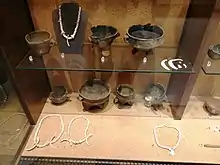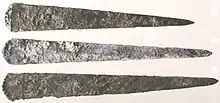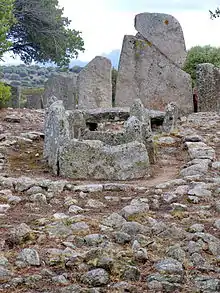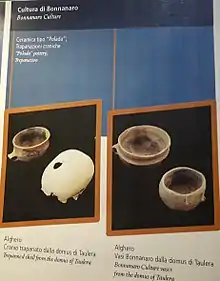Bonnanaro culture
The Bonnanaro culture is a protohistoric culture that flourished in Sardinia during the 2nd millennium BC (1800–1600 BC), considered to be the first stage of the Nuragic civilization. It takes its name from the comune of Bonnanaro in the province of Sassari where in 1889 the eponymous site was discovered.

Chronology

The Bonnanaro culture is divided chronologically into two main phases:[1]
| Phase | Dates |
|---|---|
| Bonnanaro A1 Corona Moltana | 1800–1650 BC |
| Bonnanaro A2 Sant'Iroxi | 1650–1600 BC |
Origin
According to Giovanni Lilliu the people who produced this culture probably originated in Central Europe and the Polada culture area.[2] From a material culture point of view, the Bonnanaro culture shows influences of the preceding pan-European Bell Beaker culture and of the post-Beaker (epicampaniforme) Polada culture from northern Italy.

Description
Bonnanaro sites, mostly burials, are scattered throughout Sardinian territory, with a higher concentration in the mining regions of Nurra and Sulcis-Iglesiente and in the Campidano.[3] Ceramics were smooth and linear without decorations and characterized by handles. Numbers of metal objects increased and the first swords of arsenical bronze appeared.
Only four settlements of this culture are known: Su Campu Lontanu Florinas, Sa Turricula Muros, Costa Tana Bonarcado and Abiti Teti.[4] The houses had a base of masonry while the roof was made of wood and branches.[5]
It is still uncertain whether the first "protonuraghi" or "pseudonuraghi" were built at this time, or in the successive Sub-Bonnanaro culture (or Bonnanaro B) of the middle bronze age (1600–1330 BC),[6] although c14 analysis on organic finds from the Protonuraghe Bruncu Madugui suggest that it was built sometime around 1820 BC.[7] The Proto-Nuraghi were megalithic edifices which are considered the precursors of the classic Nuraghi. They are horizontal buildings characterized by a long corridor with rooms and cells.
The Bonnanaro grave typologies include the domus de janas, caves, cists and allée couvertes.[4][5]
Physical anthropology

About 200 human skeletons of the period show that the Bonnanaro population (phase A1) was composed mainly of dolicochepalic individuals (67%) with a minority of brachycephalics (33%), the latter concentrated in the north-western portion of the island.[8] The average height was 1.62 m for men and 1.59 m for women.[9] The Bonnanaro population suffered from osteoporosis, hyperostosis, anemia, caries and tumors. Cranial trepannation was practiced.[10]
Notes
- Ugas 2005, p. 12.
- Lilliu 2004, p. 361.
- "La cultura di Bonnanaro". anthroponet.it (in Italian).
- Tanda, Giuseppe (1995). "Dalla preistoria alla storia". In Brigaglia, Manlio (ed.). Storia della Sardegna (in Italian). pp. 51–54.
- "Bronzo antico". SardegnaCultura.it (in Italian).
- Ugas 2005, p. 40.
- "Gesturi, Protonuraghe Bruncu Madugui". SardegnaCultura.it (in Italian).
- Germanà 1995, p. 131.
- Germanà 1995, p. 135–136.
- L'Umana Avventura pg.7 (in Italian)
Bibliography
- Lilliu, Giovanni (2004). La civiltà dei Sardi. Dal Paleolitico all'età dei nuraghi (in Italian). Edizioni il Maestrale. ISBN 978-88-86109-73-4.
- Germanà, Franco (1995). L'uomo in Sardegna dal paleolitico fino all'età nuragica (in Italian). Delfino Carlo Editore. ISBN 9788871381060.
- Ugas, Giovanni (2005). L'alba dei nuraghi (in Italian). Cagliari: Fabula Editore. ISBN 978-88-89661-00-0.